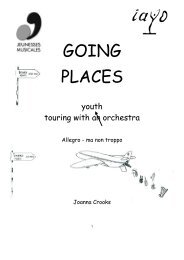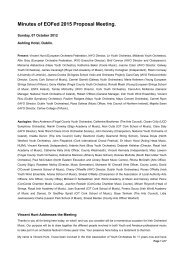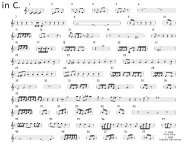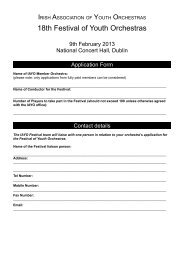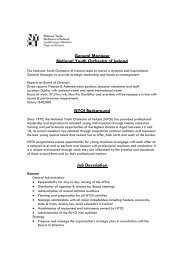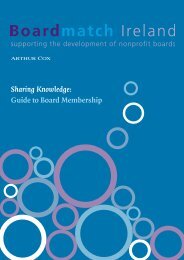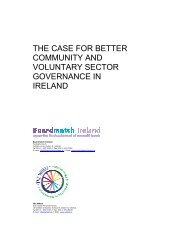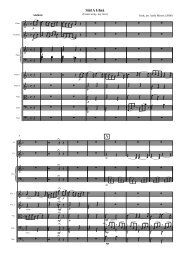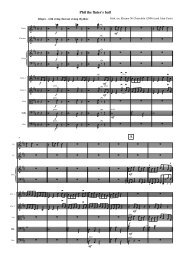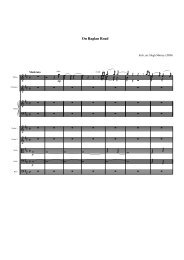A SOUND EAR II - Association of British Orchestras
A SOUND EAR II - Association of British Orchestras
A SOUND EAR II - Association of British Orchestras
You also want an ePaper? Increase the reach of your titles
YUMPU automatically turns print PDFs into web optimized ePapers that Google loves.
A <strong>SOUND</strong> <strong>EAR</strong> <strong>II</strong><br />
Key terms - noise level, average<br />
noise level, exposure and risk<br />
Noise is a fluctuation in air pressure, measured in Watts per square metre. The point <strong>of</strong> traumatic damage is<br />
100,000,000,000,000 times the quietest sound detectable by a healthy ear. To cope with such large numbers, we count<br />
the noughts - so decibels (dB) are similar to the Richter scale for earthquakes (but with the decimal point shifted one<br />
place to make decibels look substantial). A 10dB change is a ten-fold change. A 3dB change is a doubling or halving.<br />
The 5dB reduction introduced by the new law is a 69% drop.<br />
To take account <strong>of</strong> the particular sensitivity <strong>of</strong> the human ear the dB(A) scale gives more or less weighting to certain<br />
frequencies and is used for all risk measurements other than peak exposures.<br />
Noise does not have a unit equivalent to Kilos or Calories – it only has the equivalent <strong>of</strong> mph. Rarely, a noise source<br />
produces a very steady level. Usually, it fluctuates so we need to know the average level (Leq). Wear and tear on the<br />
ears depends on the average level and the amount <strong>of</strong> time it lasted – called the exposure. When relating this to work,<br />
we calculate the actual exposure and normalise it to eight hours (a nominal working day) to give the daily personal<br />
noise exposure. Thus if someone does two sessions, their daily personal noise exposure will be lower than the<br />
combined Leqs, because 6 hours’ exposure is averaged over 8. You can download an Excel macro from the Health &<br />
Safety Executive website http://www.hse.gov.uk/noise/calculator which is invaluable in calculating exposures and a<br />
useful educational tool (play around with the level and duration <strong>of</strong> exposure and see what difference it makes).<br />
Exposure is about the noise level surrounding someone’s head. Where daily personal noise exposure is/will be too high,<br />
people must be protected by wearing ear plugs or ear muffs etc, to reduce the noise entering their ears – ie. the risk.<br />
If an ear splitting sound system is playing in an empty room, the average noise level may be extreme, but nobody is<br />
exposed. If someone runs into the room to switch <strong>of</strong>f the system, their exposure may be low even though the Leq<br />
is high. If someone stays in the room to work on the system, and makes proper use <strong>of</strong> good ear protection, their<br />
exposure may be very high, but the risk could be low.<br />
What exposure period do you use? If you pay someone for a session, can you average their exposure over eight<br />
hours? We think not. <strong>Orchestras</strong> <strong>of</strong> essentially full-time players may be able to average over the day, but in the main<br />
we suggest you should only average over the time you have bought.<br />
What if a player has already used up their exposure for the day when they turn up for your session? You could make<br />
it a condition <strong>of</strong> booking that they manage their exposure so as to be able to incorporate your session (during which<br />
risks are controlled as necessary).<br />
Most Health & Safety law applies to risks arising out <strong>of</strong> or in connection with work. In respect <strong>of</strong> noise, this could<br />
mean that calculations <strong>of</strong> exposure should include personal practice, since it is necessary for their work. There is<br />
currently no consensus on this issue, and to date all orchestral noise assessments have excluded personal practice.<br />
17<br />
Photo - Claire Tregaskis



